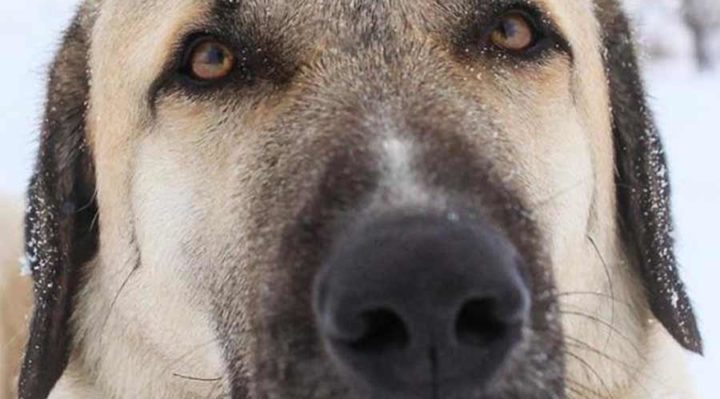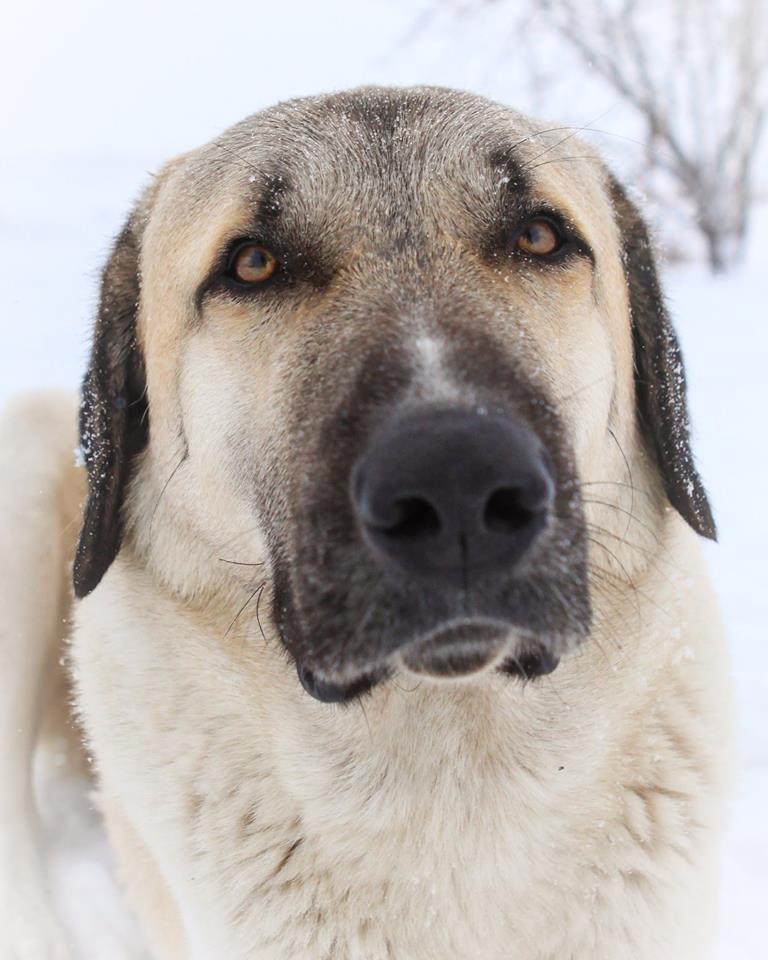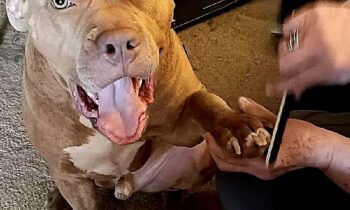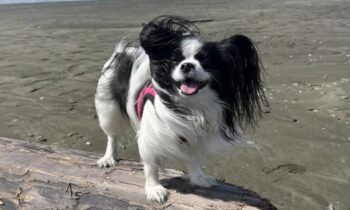
How big is a very big dog? It might be a dog that weighs over one hundred pounds. It might be a dog that’s over two-and-a-half feet tall. It might be Great Dane, Newfoundland, Mastiff, Saint Bernard, Great Pyrenees, Malamute, or a combination of any of those breeds. It’s a dog whose size appeals to some people and intimidates others. It’s a dog whose size will always attract attention, for sure!
You might be someone who’s thought about adopting a very big dog. You might have a friend or relative who has a very big dog that you like very much, or you remember a certain very big breed that was your childhood companion. You’ve seen very big dogs on TV and in videos. Very big dogs appeal to you! You wonder what it would be like to live with one as a pet.
When you’re thinking about adopting a very big dog, ask yourself:
Can you house him?
Literally, in your home, is there room for a dog this big? Where will he sleep, where will he eat, where will he hang out? What will happen when he’s old or injured and he can’t do stairs safely?
Can you transport her?
Do you have a vehicle big enough to hold a crate for a dog her full-grown size? Will you provide a ramp for her to enter and exit the vehicle? Could you lift her into the vehicle if she is unable to use the ramp?
Can you carry him?
Are there enough available healthy adults to move him on a stretcher if necessary?
Can you groom and bathe her?
Do you have bathing facilities that can accommodate her size? Can she easily access those facilities? Are there dog-bathing facilities available in your community that you could use? Can you groom her yourself on a regular basis? If not, are there groomers in your community that will groom a dog her size? Can you afford those services?
Can you exercise him?
Do you have a safely fenced back yard? Are you physically able to walk him? Do you have an alternative plan for walking him if you’re unwell, injured, or out of town?
Can you train her?
Are you physically able to do what’s necessary to train her yourself, throughout her life (not a send-away, board-to-train)? Are you able to do it in classes or with a private trainer?
Can you afford him?
Food, equipment, insurance, veterinary care and medications—all are much more expensive for a very big dog, of course . . . sometimes very much more. Then there are emergencies. You must be absolutely certain that you can commit to being financially responsible for this dog for life.
Can you insure her?
Pet health insurance for a very big dog may be very expensive. Homeowners’ insurance may not cover certain breeds or sizes of dogs.
Do you know about all the chronic health issues that very big dogs have?
They don’t live long, in general, and what goes wrong with them while they’re alive can be very expensive to treat. Can you deal with knowing your big buddy won’t be around that long?

Photo by Xan Latta
I asked dog owners and dog professionals with very big dogs about their experiences.
Ruth L. Heller DVM I grew up with Great Danes. To me, they are not big dogs, they are dog-sized, and anything much smaller than a German Shepherd is a little dog. So my experience is pretty skewed. That said, they are short-lived, and that is true of all the giant breeds. Eight years is an average, and we all rejoice when one hits ten. Medications are more expensive, surgeries are more expensive, care as they age is more difficult, especially for smaller or older people.
Training-wise, I don’t honestly think it is any more important to train them than the smaller dogs. They should all have manners. But an ill-mannered big dog can generally do more damage, even inadvertently, than an ill-mannered small dog. I will not tolerate a big dog behaving in a manner that I see many, many small dogs engaging in; i.e., jumping up, etc.
They are immensely helpful in home security—I fear nothing in my house. They like to sit on the furniture. They love to hug their people.
They are dogs . . . and that says it all, doesn’t it? They are simply made of love.
Summer Storm Kingery DVM I live with a shepherd but I think of her as average sized—she is 80 pounds with a BCS [Body Condition Score] of 4.5/9. I know a lot of heavier ones, where people seem proud of excess pounds. I lived with a Great Dane when I was younger.
My perspective as a vet is that people who are going to have big dogs really need to consider the costs for basic things like antibiotics. When a dog has to have five tablets three times a day of a mid-priced drug, we can easily be in the several hundreds of dollars. When Arrow has a major bone infection, her three months of antibiotics were over $500/month and they weren’t the expensive ones. Thank goodness for pet insurance. The other thing is planning for mobility later in life.
Steve Christilaw Julie has said that, at first, River, our Great Dane, was such a big dog, but before long she just became our dog and you don’t really notice how big she really is (130 pounds). You have to watch out for her enthusiastically wagging tail, but aside from that she is a great dog and incredibly gentle. She’s great with the grandkids and was fantastic with our grandson when he was an infant. You get used to having a wet nose waking you up first thing in the morning. With a Great Dane, you know going in that you aren’t going to have a really long time with her. The life expectancy on a Great Dane isn’t that long (about 10 years).
Lauren Shelley You never will go to the bathroom alone, cook alone—you will do nothing alone ever again. They are in the way, and it gets frustrating, but then suddenly they do something to make you smile and all is good. They are the best. Yes, they drool. Yes, they have big pee and poop. But they’re well worth everything. They make my heart sing.
Mark Hadley I live with a big dog, Heidi—she’s a Leonberger. Heidi is 60kg [about 132 pounds]. She has just turned four. Heidi was my first puppy and is an absolute dream to train . . . all but on the day I was doing my bronze good citizenship test! We were in the middle of doing the sit stay and her sister Izzy, a black Labrador, walked past. Heidi jumped the fence to say hello, came back when called, of course, and we still passed. Tips: Train a awesome recall; loose lead is a must.
Pauline Nina Daniels We have a Newfie, a Bernese, and a Saint Bernard cross—the zoo (we have three cats, too). Training-wise, you have to be firm and consistent and really be on top of it. Most people you meet will judge them harshly. If a little dog jumps, barks, demands attention, it’s cute; if a big dog does it, it’s seen as threatening (especially when the person has picked up their little dog!). If you don’t train good walking, they will walk you. We’ve used positive reward training with all of them for almost everything, consistently marking good behavior. Very important to think about when buying a puppy is health checks—hip and elbow scores. Also, don’t over-exercise a puppy (a minute walk a day for every week of age). Medication/sedation, etc., is so expensive when they are big.
The cats (well, one of them) rule the roost in our house! Took getting on to a year for each dog to adjust to that. The older dogs took 6–10 months to relax with the cats, and the cats a year to relax with an unpredictable puppy. Sammy has been the hardest because of his hard focus and herding, but he’s been bopped a couple of times and is scared of them all. We took it slow and used crates to introduce them to each other, have a baby gate to keep them apart when we’re not there (they all could but don’t jump it), and make sure the dogs have a cat-free conservatory and garden while the cats have dog-free high space and all of upstairs.
Gail Jackson I have a Giant Schnauzer and he is my fourth. You learn to keep items off the counter unless you want them stolen. It’s not counter-surfing if it is head high! Sometimes the top of the fridge is not tall enough, so behind [a closed] door is always best. Bigger water bowls and bigger spills. They may be big but they still like love and will crawl in your lap or on the bed next to you. When you purchase a new car, you think about crate space and if the dog will fit so you still have room for luggage. You also learn to step over sleeping dogs, or at least dogs lying down.
Christine Hale Vertucci Be prepared for lots of weird comments such as “Are you walking him or is he walking you?” Owners of small dogs will pick up their dogs when they see you coming, and some pedestrians will cross the street to avoid you. If you travel with your dog, finding hotels that allow dogs over 80 pounds can be a challenge. Some apartments and condo buildings have size limits. They cost a lot to feed, and their monthly heartworm preventatives will cost more. Most importantly, I recommend a king-sized bed.
Kristy Gibson I have a six-year-old Neapolitan mastiff at 150 pounds and an 18-month-old English x Brazilian [mastiff] at 120 pounds who is still a bit gangly. There’s plenty in what people would classify the “cons” list. Shorter lifespan—he’s six years old and I treat Roscoe as an old man now, even though he’s in quite good health physically. But preventative arthritis care, routine joint and brain supplements, regular massage and physio, routine blood and lump checks are all starting now, and I don’t really expect he’ll be with us in two years.
Training—a non-negotiable. You can’t not have a reliable line of communication for a dog this size, but you don’t have the physical ability to control them. Roscoe would not have a problem pulling a 120kg [260-pound] guy off his feet if he was excited and started to run at something. Even just having the ability to back them up or station them in spaces in the house can get tricky. If you don’t have those things on cue, there’s definitely gonna be some broken things in the house. Even large NICE dogs might not be good novice dogs due to size.
Vet bills are huge. Even a simple course of antibiotics is going to run into the hundreds of dollars, so you need insurance or at least a back-up fund for bills. Surgeries are going to be +20–30% just due to size and drug costs. When things go wrong, it can get expensive quickly.
Physical logistics—they’re hard to take out for coffee. Do you have a car big enough to cater to them? Do you need them to fit in a hydro bath? You’ll have to train for that. Kids need supervised play, not free range. They aren’t usually problems that you can’t get around, but they do require consideration.
Jennifer Shryock B.A. CDBC, Founder/Director of Family Paws Parent Education I love our gentle giant. He is, however, a LOT of muddy paws when it rains, big accidents, if they happen, and HUGE expenses for vet and food. That said, we adore our Oliver.
Raising a giant-breed pup can be challenging, as your puppy will be HUGE compared to other puppies. Many times this intimidates other puppy owners. When you say your big guy is still a pup, but he looks the size of a full-grown dog, this can create challenges in socialization situations with other dogs. Large pups do not know their size and can easily overwhelm other pups or small dogs while they are learning how to handle their large paws, legs, etc.
One MUST tip for parents of young children considering a large or giant breed is to teach a “side” cue. I loved this for our boy. “Side” meant to lie flat on his side and he would get belly pets. We began practicing this without my daughter. Then once the dog had mastered the position, we added her to the mix. A giant breed of dog can intimidate small children and this [training] allowed both Oliver and my daughter to know what was going to happen and when petting was okay. Every morning, Oliver would flop on the floor on his side to invite her to pet him. She is now almost nine and this is still part of their routine. Oliver will lie on his side and only move his eyes and give a gentle wag if she has not come to pet him. Very nice!
Debby McMullen Certified Dog Behavior Consultant, IAABC When I got Kenzo, a Caucasian Ovcharka, now 185 pounds, I knew that he would be very large and I did not want a suspicious giant-breed dog. I wanted this dog to be an ambassador for his breed, especially because some people promote the breed as aggressive. That’s not how they’re supposed to be. So I heavily socialized him from a young age. I had parties with people coming over specifically to meet him. I took him to puppy socials every other week, I took him to a local dog-friendly venues, I took him to large-dog socials once he aged out of puppy socials. I took him to dog-themed events. It was always his choice to interact or not. He really enjoys people and attention.
I had two other dogs when I got him and one of them taught him a lot. He has only ever been trained with positive training. He loves the clicker and he knows that whenever he sees something/someone when we’re out walking, that’s his cue to look at me if he has a question, and he will be rewarded for that. He’s definitely too big for me to manhandle, but there’s no reason for that kind of training on any size dog.
Nick Hof CPDT-KA (Certified Professional Dog Trainer-Knowledge Assessed), CBCC-KA (Certified Behavior Consultant Canine-Knowledge Assessed), KPA-CTP (Karen Pryor Academy–Certified Training Partner), CSAT (Certified Separation Anxiety Trainer) There are some different things to consider when a novice dog owner may be getting a giant-breed dog.
Life expectancy tends to be shorter, though not always. I just lost one of my Saints less than two weeks ago, just shy of turning 13 years old. I lost another, though, several years ago right before he turned four, due to health issues.
Vet expenses can be higher for some of the specialty issues that come with larger dogs, such as bloat, hip issues, heart, etc. Medications will also be a lot more expensive because these guys need a lot more. You also need to have a plan for how to help them if you need to move a dog that is larger than you in an emergency, such as having a sheet or stretcher on hand.
Behavioral issues can be a lot more important to address. Pulling on leash can be a huge problem when your dog can literally drag you down the street, so working on good manners early is smart. Fearfulness and aggression are also much more of a concern due to size, so socialization and positive training with a good trainer is incredibly important.
There are good things about them, though! Giant breeds “tend” to be less energetic, so despite their size they can make good dogs for apartments as long as they still receive appropriate exercise. They are amazing companions and have been so wonderful to have in my life.
If they are bigger dogs with longer hair, that can be a lot of hair, so be prepared for tumbleweeds and regular grooming!
Here’s a link to a short video by Nick Hof about owning a large-breed dog:
Big Dogs, Big Hearts—The Difference in Owning a Large-Breed Dog
https://www.youtube.com/watch?v=tV5oGo9BQn4&feature=youtu.be



